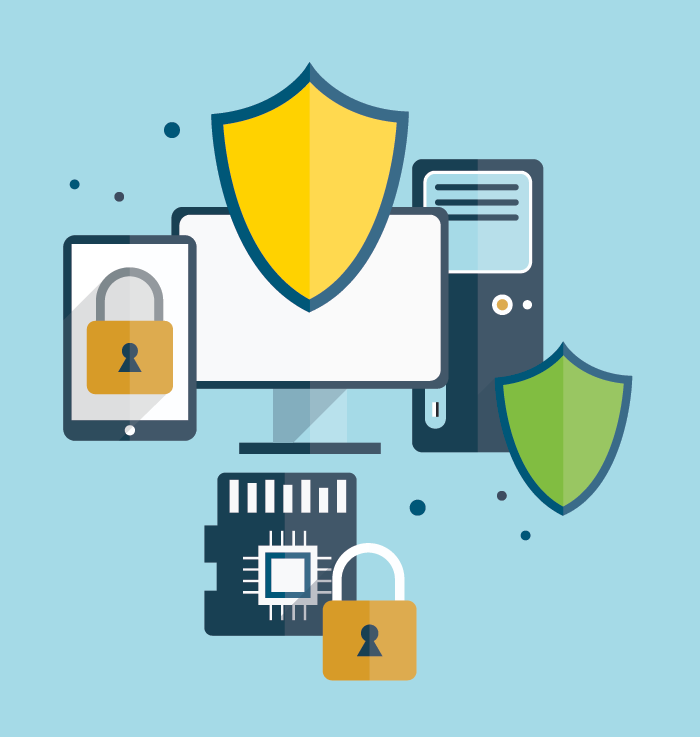The Next-Generation Layer of Cybersecurity
Cybersecurity best practices are always changing, and you can feel overwhelmed just trying to keep up.
Why?
It’s the endless cycle of the good versus bad—the trustworthy IT pro versus the scary, evil hacker. The good team builds a safer, more secure cybersecurity solution. The bad team eventually finds a weak point to crack the new cybersecurity solution, and then the good team finds a better way to keep the bad team out.
Rinse and repeat.
The next latest, greatest solution in the world of cybersecurity is Endpoint Detection and Response (EDR). Traditional cybersecurity solutions work by monitoring for predefined bad actions. For example, your anti-virus software can identify potentially harmful files, because it checks data from files on your computer against a database of known viruses. Once identified, the anti-virus software can isolate and remove the data; however, it must discover the virus before it can act. In the meantime, the virus is running in the background, multiplying, and compromising your sensitive data.
EDR works in real-time by monitoring, collecting, and recording data to identify and detect malicious behavior. Using EDR, cybersecurity professionals have sophisticated tools to analyze an entire network and its endpoints (computers, mobile devices, printers, tablets, etc.) before a cyberattack takes everything down. System administrators also have the tools to identify past incidents to patch cybersecurity flaws in your system.
With hackers continuing to develop more advanced ways to gain access to your network and devices, next-generation cybersecurity solutions, like EDR, are an essential component that businesses need to maintain privacy and stay safe.
What Is EDR?
EDR is an advanced, business-accessible cybersecurity solution. Instead of relying on user-initiated scans and predefined viruses, EDR monitors your devices and network in real-time to:
- Detect potential cyberattacks
- Isolate infected machines
- Alert system administrators
- Remove cyberthreats
EDR works by monitoring your network’s endpoints in real-time. Using advanced technology capabilities to analyze data and files, EDR recognizes system behavior anomalies before a cyberthreat takes down your entire system. Once a device has been infected, EDR quarantines it and notifies the system administrator that a cyberattack has been detected.
With EDR, your business gets advanced protection against the most advanced threats that often go undetected, such as ransomware and malware. With these advanced capabilities, EDR can detect threats that hide in the shadows for weeks.
Do You Need EDR and Anti-Virus?
The short answer, as you would probably expect, is yes.
A stronger, smarter defense: anti-virus + EDR
Anti-virus is a critical layer of an effective cybersecurity solution. It does a great job of protecting your technology by searching for, detecting, and removing computer viruses, especially when all your devices are being actively monitored on an internal, on-premise network.

Consider how your anti-virus works:
- Scanning. Anti-virus works by scanning files and directories for malicious applications and files. Whether automatically scheduled or user-initiated, someone needs to start the scan to begin looking for viruses.
- Definition-based. The anti-virus needs to be able to differentiate between good and bad files to detect a computer virus. Most anti-virus software works from a list of predefined, existing known viruses. Technology is continuously evolving, and so are cyberthreats. Anti-virus definitions need to be continually updated as new threats are identified.
- Isolation and quarantine. Anti-virus programs are good at identifying and removing malicious programs. However, once detected, the virus can continue to spread until you remove it. Anti-virus programs aren’t the best at isolating devices and quarantining them from infecting others upon detection.
- Response time. Since anti-virus doesn’t work in real-time, it takes valuable time to scan, investigate, and remove malicious applications and files.
Protect remote workers and equipment
When your workforce is distributed remotely, either full-time or part-time, a basic anti-virus foundation can benefit from a more advanced cybersecurity solution. Some viruses, like ransomware, could be hiding out on remote machines waiting to infect the entire business when a device reconnects to your on-premise network.
Next-generation cybersecurity solutions, like EDR, use artificial intelligence and machine learning to supplement definition-based anti-virus programs and protect businesses against sneakier cyberthreats.
How Much Does EDR Cost?
Rather than a standalone service, you should consider EDR as a piece of your business’s overall security strategy. Alongside firewalls, endpoint protection, email security, user education, and data backup, EDR is part of the cybersecurity puzzle that helps keeps your business safe.
When determining the cost of a business’s cybersecurity solution, the price varies based on factors such as the size (small, medium, or enterprise?), type (lawn and landscape will have different cybersecurity needs than a government agency), regulations (HIPAA and PCI-compliance?), and location (on-premise, remote, or hybrid?) of an organization.
To determine the overall cost of your business’s cybersecurity solution, we meet with you to discuss your wants, needs, requirements, and goals.
We Keep Businesses Safe.
High Touch is equipped to design, implement, and support any sized organization’s cybersecurity requirements in any industry, ranging from basic firewall solutions to next-gen anti-virus and EDR. Contact us to learn more about the cybersecurity solutions we can offer your business.
